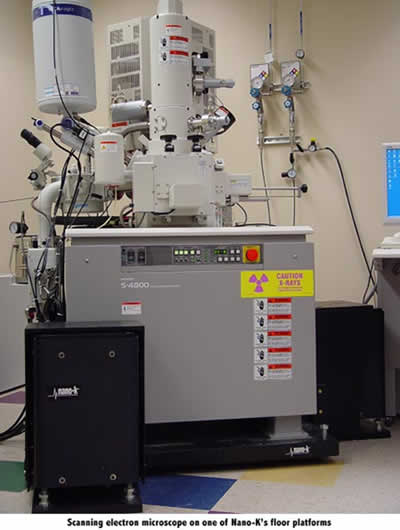
6Moons.com
- October 2006
Audio Review
Minus K 25BM-8


Reviewer: John Potis
Analog Source: Rega P9 turntable, RB1000 & Hadcock
GH Export arms, Benz Micro MC Silver, Rega Super Elys &
Garrott Bros Optim FGS Cartridge
Digital Source: Accustic Arts Drive 1/ Audio Aero
Prima SE DAC
Preamp: Bel Canto Pre2P
Power Amp: Art Audio Carissa, Bel Canto e.One REF1000
and Canary CA 160s, Musical Fidelity A5 Integrated
Speakers: Hørning Perikles, Anthony Gallo
Acoustics Reference 3.1, Ohm Acoustics Walsh 4 with 4.5
mk.2 upgrade, Tidal Audio Piano
Cables: JPS Labs Superconductor and Superconductor
FX interconnects and speaker wire, Furutech Digi Reference
digital
Power Cords: ZCable Heavys, Red & Black Lightnings,
JPS Power AC, Analog AC, Digital AC and Kaptovator power
cords
Powerline conditioning: Balanced Power Technology
3.5 Signature Plus with ZCable Cyclone Power Cord
Sundry accessories: Sound Mechanics Performance Platform,
2-inch Butcher Block platforms with Quest for Sound Isol-pads,
Vibrapod Isolators and Cones, Ultra & Heavy Zsleeves,
Viablue QTC spikes under speakers, Auric Illuminator
Room size: 12' by 16' with 9' ceiling
Review component retail: $2,400 to $2500 depending
upon weight capacity
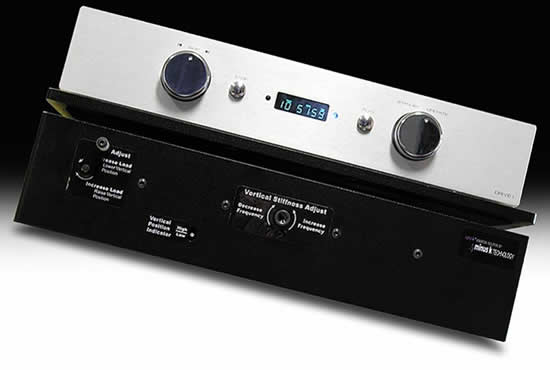
In all likelihood, you've not heard of Los Angeles-based
Minus K Technology. While they're fairly new to audiophile
circles, they are not a new company but have been pioneering
spring-loaded isolation devices since 1993. Minus K was
founded by Dr. David L. Platus who today serves as the company's
president and principal inventor. Minus K was founded to
develop, manufacture and market products based on patented
negative-stiffness mechanism technology.
Platus himself holds B.S. and Ph.D. degrees in Engineering
from UCLA and a diploma from the Oak Ridge School of (Nuclear)
Reactor Technology. His credentials include a career in
the nuclear, aerospace and defense industries conducting
and directing analysis and design projects in structural
mechanical systems and then becoming an independent consultant
in 1988. Today Dr. Platus holds over 20 patents related
to shock and vibration isolation.
Currently sold under the trade name Nano-K®, Minus K
Technology's products represent an important enabling technology
by optimizing the operation of vibration- sensitive instruments
and equipment to unprecedented levels, reducing building
and floor vibrations. Minus K customers include private
companies and more than 150 leading universities and government
laboratories in 25 countries. For the extensive list of
Minus K customers, click here.
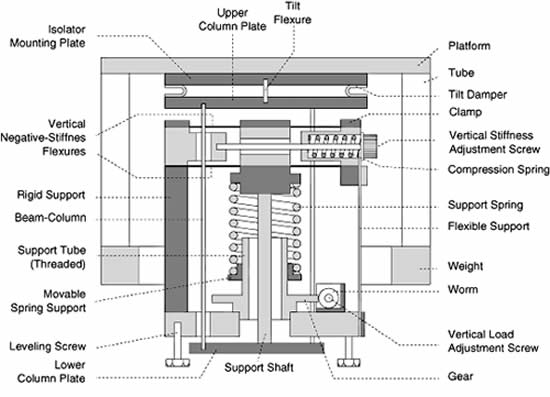
I asked Dr. Platus to comment on a few of his more interesting
customers and outré applications: "Our main
customers are users of instruments and equipment that is
very sensitive to vibrations. One class of such instruments
are scanning probe microscopes (SPMs) that are used in nanotechnology
and can resolve features as small as atoms and molecules,
and can also move the atoms and molecules around to create
"nano structures" that have unusual properties.
Researchers use SPMs in many fields from biology to semiconductors
to materials research.
"Another class of vibration sensitive instruments are
micro-hardness testers that are used to determine mechanical
properties of materials used in a variety of fields. They
measure force-deflection curves and the deflections could
be only a few nanometers. A nanometer is one billionth of
a meter. There are about 50,000 to 100,000 nanometers in
the thickness of a human hair.
|
"A number of "cool" applications
come to mind. One application is that of a researcher
who used our isolation system in the study of the
effects of vibrations on fish. External vibrations
in the lab were interfering with the research. Another
application of our isolators is with fluorescent
dye imaging equipment for studying neural activity
of the brain. Fluorescent dyes are injected into
the brain and weak optical signals indicate which
part or the brain is active for various stimulations.
The optical signals are very sensitive to vibrations.
|
Minus K isolation products are said to employ
a revolutionary concept of low-frequency vibration isolation.
How low a frequency? Try half a Hertz. If you have a hard
time relating, imagine depressing a spring-suspended platform
and then releasing it. Its spring loading causes the platform
to rise until it surpasses the platform's resting level
before starting its descent again. Up and down like any
spring-loaded device until it comes to rest half-way between
its highest and lowest points of travel.
But here's the kicker. From lowest point to highest point,
this takes a full second to complete the journey. One second
of upward motion, one second of downward motion equal a
half-second low-pass filter on vibration. If you now think
that no vibrations above .5 Hz make it past the 25BM-8 platform,
I don't blame you, that's what I thought. However, it's
actually not the case.
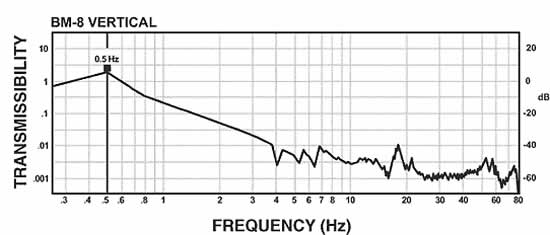
Check out the above graph. It's the transmissibility curve of the BM-8 platform. Transmissibility refers to how well a vibration is transmitted through the platform and into the component being isolated. The graph shows the transmissibility along the vertical axis and the vibration's frequency along the horizontal axis. Notice how the transmissibility varies with frequency.
A transmissibility of one would equate to no isolation at
all. As the floor moves, so does the component. It's a one-to-one
ratio between floor movement and component movement. Notice
that the graph shows that at the .5 Hz tuning frequency,
the 25BM-8 is actually amplifying the vibration through
the component - it shows a greater than one-to-one transmissibility.
However, by the time the frequency rises to 1.5 Hz, the
transmissibility is already down to .1. This represents
a ten-fold reduction in amplitude, equating to a reduction
of 20dB. By the time we reach just shy of 4 Hz, we've achieved
a transmissibility of .01, representing a 100-fold or a
40dB amplitude reduction of the offending vibration. You'll
also see a plateau of sorts between 25 and 40 Hz at which
time transmissibility is at .001 for a 1000-fold attenuation.
You'll also notice that the graph stops at 80Hz. Keep in
mind that the 25BM-8 is an industrial product mainly designed
to isolate objects from structurally born vibration. Audiophiles,
with the introduction of music into the room, create quite
another kind of environment. Dr. Platus informs me that
things get very complicated above 80Hz because we begin
to have to consider resonant frequencies of associated components
and even the structure of the 25BM-8 itself. In other words,
while isolation is drastic, it varies from situation to
situation. Keep in mind this idea of varying resonance frequencies
when I start talking later about using the 25BM-8 under
a turntable. Things get very interesting.
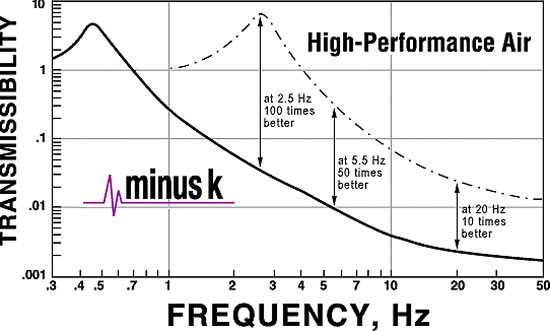
In the meantime, take a look at this next graph. You'll
already be familiar with the transmissibility curve. However,
the dotted line indicates the transmissibility of a high-performance
isolation device using air rather than springs, such at
the well known Vibraplane device. Notice that while both
products amplify the vibration at some frequency, the air
device amplifies it at a much higher frequency and that
at 2.5Hz, the 25BM-8 has already achieved a 100-fold greater
isolation and at 5.5Hz it's operating at 50 times the effectiveness
of the air platform. Only by 20Hz does the air table begin
to catch up but the Minus K device still has ten times greater
effectiveness.
So much for the technical stuff. To help visualize how the
25BM-8 actually achieves its goal, it may be beneficial
to picture an ocean liner on rough seas. We've all seen
such a scenario in the movies. Multiple waves crash against
the much larger ship, causing it to move, slowly, up and
down. The ship's movement as it undulates up and down, fore
and aft, may be great in terms of amplitude (distance traveled)
but its frequency -- the intervals between the changing
of directions -- is very low. In practice, the Minus K 25BM-8
platform works just like that. It's the ship on the rough
sea that just happens to have your components aboard.
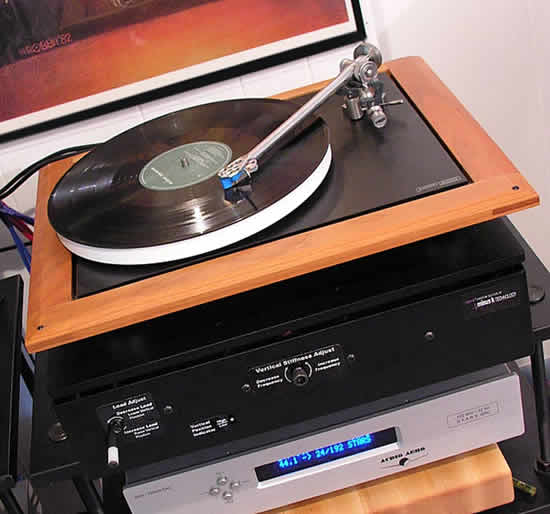
Place a turntable on the 25BM-8 and jump up and down on
the floor. Unless you're on the basement-level concrete
floor, the floor will flex, very quickly and abruptly, enough
to cause a turntable's cartridge to jump up and out of the
groove. But if the turntable sits upon the BM25-8, the turntable
will move like that ocean liner, very slowly, very smoothly,
up and down. The base of the Minus K moves abruptly below
the floating platform, however no matter the abruptness
of the flexing of the floor (the frequency), the 25BM-8
acts as a high-frequency filter and the component-loaded
platform is oscillated at a rate of only .5 Hz. Slowly and
smoothly the turntable is set into motion and slowly it
comes back to rest. Not only is the cartridge/groove connection
maintained, not only does the cartridge not skip, but you
don't hear wow or flutter because the frequency of the vibration
is beneath the response of the cartridge and the system.
The 25BM-8 also adds a significant amount of isolation in
the lateral plane. Why that would be important I can't say
(unless your turntable was mounted on a wall), but I'm sure
that sometime soon it'll be demonstrated. The lateral (or
horizontal) frequency is payload/weight dependent and is
in the vicinity of 1.4 Hz at the upper end of the payload
weight range. The frequency increases as the payload weight
is reduced. I'm told that the frequency is 1.6Hz at 25 pounds,
1.9Hz at 20 pounds and 2.5Hz at 10 pounds.
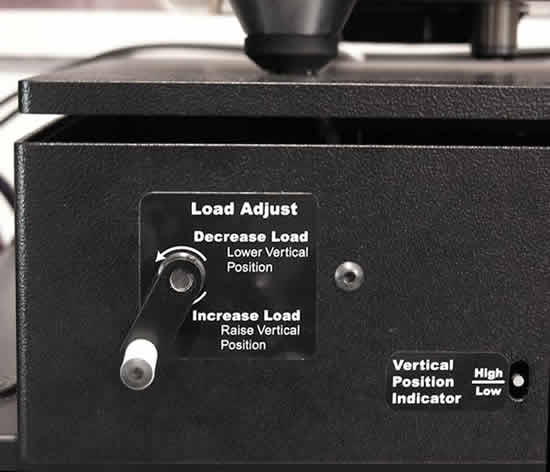
There are two adjustments to be made when using the BM25-8. On the platform's front left panel is a crank that centers the platform within its range of motion. It's a load adjustment. Once a component is placed on the platform, if it's not weighty enough to properly depress the springs, it'll ride near the top of the platform's range of travel. If the component is heavier, it'll depress the springs and the platform will ride near the bottom of its travel (if it doesn't bottom out completely). The load adjustment has the effect of changing the preload of the springs, incrementally, so that the platform is raised or lowered to the center resting position. Why is this important? Because as the component is set in motion, if it rests near the top of its range of motion, the platform will slam against its uppermost stops. If it rests too low, one modulation will have it bottoming out against its lower stops. As it hits those stops, the jarring effect is at least as detrimental as the vibration you're trying to eliminate. In the case of turntable suspension, such a jarring action will both send audible noise through the structure of the turntable as well as pop the stylus from the groove. Centering is very important. It's also very easy to accomplish.
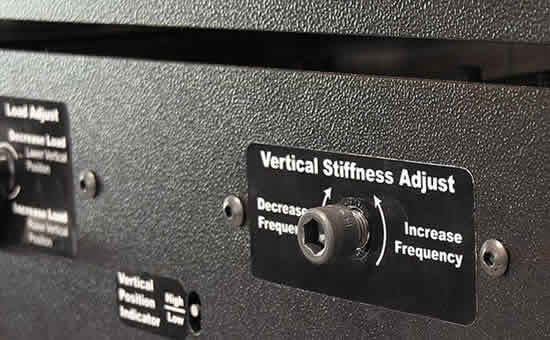
Before you center the platform, the center frequency of
the spring mechanism may have to be adjusted. For this,
the center-most adjustment is used. Using a 5/16" Allen
wrench (not included), this adjustment can be rotated in
either of two directions, to raise or lower the filtering
frequency. The platform is delivered set to a frequency
of .5Hz but as I switched between turntable and CD transport,
I found that I needed to make this adjustment. One simply
turns in very small degrees until the depressed and loaded
platform raises again at the correct rate of speed. Minus
K actually uses a metronome to make this initial adjustment
at the factory. The manual warns to make adjustments in
very fine degrees and this warning should be heeded. Too
large and impatient a turn and you'll find yourself so well
out of the proper operating range that finding it again
could be frustrating. You eventually will but the situation
is best avoided.
Before I get to the sonic effect of the 25BM-8 platform,
I need to go through some practical ramifications of use.
As compared to other products of its ilk, two very positive
aspects of the 25BM-8 are the facts that the Minus K products
don't make use of air bladders -- which as anybody who uses
them can tell you, require very frequent adjustment -- and
as it's completely passive, it won't require one of your
precious electrical outlets either.
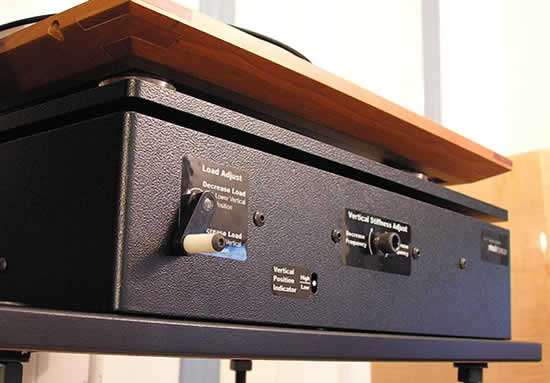
I used the 25BM-8 platform under both my CD transport as
well as under my turntable. Recall my ship analogy. Now
shrink the scale to that appropriate for audio components
and picture them floating in your bathtub. Now picture yourself
cueing a record while that turntable floats in your bathtub.
If you have a top-loading transport that requires the sliding
of the compartment cover, imagine sliding it open as the
transport floats on water. The entire transport wants to
move away from you. The floating suspension of the 25BM-8
platform gives a whole new level of complexity to changing
records, too. Use of the cueing lever sets the entire turntable
into motion. Even lifting the record from the platter has
the effect of lifting the entire turntable slightly into
the air. The component resting upon the 25BM-8 platform
is effectively weightless and extremely prone to being set
in motion. Stiff power cords and interconnects now have
the ability to suspend the weightless component and interfere
with the 25BM-8 platform's task - a real tail wagging the
dog scenario. In my case, I couldn't use the Furutech Digi
Reference digital interconnect due in equal parts to the
cable's stiffness and the in-line filter's weight. The Rega
table's power cord and interconnects, while lighter and
softer, had to be configured so as to not hang directly
off the edge by the turntable. Instead I routed the cables
such that the bulk of their weight rested on and along the
platform of the 25BM-8 and then continued on their journey
from there. In a permanent situation, I can easily envision
tethering cables and power cords to the wall behind or at
least the equipment rack in order to relieve strain and
to support the cable's weight.
Also of note is that the 25BM-8 works better when the component
being suspended weighs in toward the top of the platform's
payload limits. While the 25BM-8 is rated for components
up to 30 pounds, it really isn't optimized for a component
of as little as 10 lbs. Where exactly that cut-off is, I
can't say as I have no components that light. But I did
find adding some weights to the platform while the Rega
was in use aided the 25BM-8 in more effectively performing
its mission. Before the addition of the weights, I had a
difficult time leveling the platform and zeroing in on its
filtering frequency.
Lastly, it was frequently necessary to set the load adjustment
when changing records because the weight of the record varies
from LP to LP. A heavier LP would require a raising of the
platform, a lighter LP a lowering. This was a little disconcerting
at first but very quickly did I become accustomed to making
the adjustment on the fly as it became part of the routine.
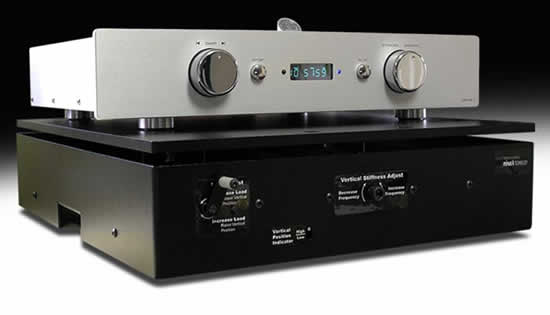
There's no question, the 25BM-8 added a level of complexity to the playing of both LPs and CDs that would eliminate it from consideration were it not for some practical benefits and some positive sonic ramifications. Just about everybody who spins vinyl but doesn't have the luxury of a concrete floor beneath will love at least one aspect of the BM25-8's performance. Once properly adjusted, I could jump up and down on the floor in front of my turntable with no ill effects whatsoever except for my ankles. It was actually pretty cool to watch! The turntable all but floated on air as the component rack and the bottom portion of the 25BM-8 moved -- sometimes violently -- beneath it. Of course, the Rega wasn't actually suspended motionlessly in mid air but it was moving so slowly, relatively speaking, as to almost defy detection. Suddenly my girls could dance around the room to the music while it just played on and on. If the 25BM-8 accomplished nothing else, its effect of nullifying foot falls would be enough to justify its existence in a lot of rooms.
So, how does it influence the sound? Well, it sounds great.
One phenomenon that I'm unable to explain is why all reviews
of cones, pods, isolating platforms and coupling spikes
read so much alike and in doing so, seem to inspire conspiracy
theories and accusations of snake oil. Why do they all improve
the soundstage? Why do they all seem to improve bass response?
Open up the treble and create a greater sense of air? I
don't know. I have no idea what it is that makes the bass
and treble frequencies -- as they travel through electrical
components -- so fragile. But they certainly seem to be
and the 25BM-8 does an admirable job of preserving them.
For sure, bass solidified when the 25BM-8 was used under
my source components. It became subjectively more extended
and more solid. It had greater impact as well as detail.
How much better? The answer to that question will depend
on how much attention you've already lavished on your system
where vibration isolation or resonance tuning is concerned.
If you're using a cheap stand with nothing between it and
your components, then you probably can't imagine what awaits
you. The change will likely be drastic.
In my system, 'I've been using Vibrapods for years and
these little wonders work wonders. Recently I've acquired
2"-thick maple cutting boards for under my components
and further improvements have been made. I've already achieved
heightened levels of bass solidity, focused soundstaging
and subjectively lowered noise levels. Where the 25BM-8
made additional improvements, they were indeed subtle as
they were made over and above what I'd already achieved.
If you think about that for a moment, that's already saying
something significant.
But don't make the mistake of confusing subtle with negligible.
What the 25BM-8 brought to the listening experience was
never negligible. When I removed all the maple boards, pads
and pods from the component and substituted the BM25-8,
there were no downsides nor backsliding. That's a pretty
good start. There's nothing that those treatments can do
that the 25BM-8 can't. Where it came to affecting bass,
treble and soundstaging, it was pretty much a wash. There
were additional improvements, however. Improvements that
I couldn't hope to achieve by other means available to me.
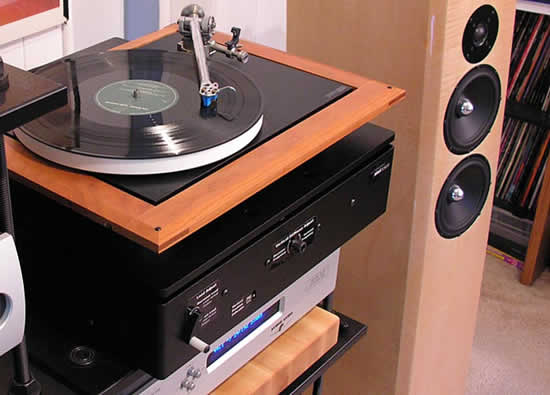
With the 25BM-8 in the system, the presentation took on
a subtle yet very important increase in texture. Imagine
viewing a painting behind a very clear piece of glass and
then removing that piece of glass. It looked pretty good
before but suddenly you can make out additional degrees
of depth and detail in not only the colors but in the texture
of the paint itself. This equates to microdynamics which
are more highly differentiated. Not monumentally - I'm being
careful to avoid hyperbole. What we're talking about is
a slight yet important difference. There's no need to exaggerate
the magnitude because if I were able to quantify the improvement,
it could be as little as a 5 or 6% improvement. But if you've
ever achieved such a subtle improvement in your system by
various means, you know how monumental that added degree
of enjoyment can actually be. Sometimes 1 + 1 easily equals
5. It does so because anything that adds to the suspension
of disbelief can have a logarithmic effect on the enjoyment
scale. If you can relate to what I'm saying, you can also
relate to the fact that once an incremental improvement
is achieved, it's difficult to give up on. Often, there's
no going back.
I guess the point I'm trying to make is that if you've already
paid due attention to vibration control, don't insert the
25BM-8 to expect the kind of transformation that causes
you to drop the book you're reading. But you will hear meaningful
improvements that may be extremely difficult to achieve
by other means.
If you're just starting your own battle on vibration, you
may have a darn difficult time wiping that big grin off
your face. You'll likely experience increases in performance
well beyond what buying new electronics can produce - for
a lot less money, too. Typical improvements come at both
frequency extremes, plus additional dimensionality, focus
and a seemingly lowered noise floor with improved microdynamics.
What I enjoyed the most about the 25BM-8 was the fact that
it allowed me to see the brush strokes of music upon its
canvas with vivid clarity. Again, we're not talking bang-the-door-down
night-and-day differences. We're taking about subtle yet
easily perceptible differences that add significantly to
the sense of realism. Suddenly I could see dimensionality
in the music that I never had. What had previously been
smoothed over or slightly blurred now had greater texture
and appreciably more appeal. What had previously sounded
as smooth and texture-free as silk was now revealed with
the texture of fine tweed. Breaking away from this analogy
and explaining exactly what you will hear is most difficult.
It relates to an incremental layering of the soundstage
and imaging for starters. You won't hear things forward,
middle and to the rear of the soundstage. You'll hear much
greater graduation between those base positions. You'll
hear more dimensionality to individual instruments. Even
more importantly, you'll get greater delineation between
blacks and grays. The listening experience takes an important
step toward becoming a visual one.
The 25BM-8 comes tuned for a .5 Hz filter, which may or
may not be optimal for your system. The 25BM-8 allows you
to experiment and determine exactly what is right for your
system. A half Hertz seemed just fine under my CD transport
but under my turntable, it seemed a little low. Via rotation
of the tuning adjustment, I was able to lower the BM25-8's
tuning and raise it. Under the Rega, this had a very interesting
effect on the sound.
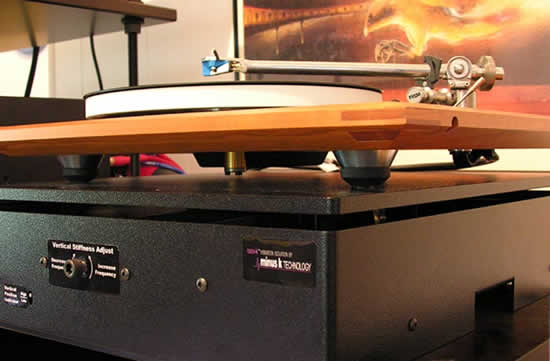
Some claim (with a surprising degree of accuracy, in my
view) that components sound like what they are sitting upon.
To a limited extent, this was the case with the 25BM-8.
Loosening up the suspension, lowering the frequency just
a little bit and the music became soft and willowy. Bass
seemed to lose just a little solidity and the tempo seemed
to bog down just a bit. Soundstage swelled but focus diminished.
Tuning the 25BM-8 in the other direction and things tightened
up nicely. Focus was improved, bass became tighter and tauter
and the system took on a proper sense of pace. Tightening
it too much -- raising the frequency too high -- and the
presentation tightened up, too. A spacious soundstage dried
up though focus increased. Bass seemed tight and highly
damped but lacked some of its previous oomph.
Frankly, this whole effect had me scratching my head. At
no time was the Rega as firmly coupled to the shelf beneath
it as when it sits on its own feet directly on the shelf.
It soundstaged pretty well on its own so how could raising
the frequency of the platform cause the soundstage to dry
up to a greater extent than when the table was firmly coupled
to a solid shelf? It seemed to me that the logical extension
of this tuning phenomenon was to move the turntable from
the 25BM-8 and to a solid equipment rack shelf, in which
case the soundstage should completely dry up and blow away.
But, of course, this is not the case.
Well, remember earlier when I was talking about the unpredictability
of the transmissibility at higher frequencies? It would
seem that as I adjusted the tuning frequency of the Minus
K device, what I was also doing was tuning or retuning the
resonant frequencies of the turntable and/or the 25BM-8
itself. As the supporting structure (the springs) became
more or less stiff, it would have to effectively alter the
damping effects of the loading system as it, in turn, changed
the resonant tuning of the turntable and platform above.
In this way, we'd moved beyond isolation and into the realm
of resonance tuning. Without a doubt, the more I delved
into the aspects of the 25BM-8's attributes, the more interesting
things became.
Conclusion:
So there it is. From the standpoint of its impact on a system's
sonic appeal, the Minus K 25BM-8 is all positive and its
effects will likely come down somewhere between mind-blowing
and subtle yet important - depending on how deeply and successfully
you've already gotten into the elimination of vibration
in your system. Due to the various weights involved and
the fact that I received only one Minus K 25BM-8 for evaluation,
I haven't even gotten into what can be achieved when used
under preamplifiers - both tube and solid-state, and power
amplifiers and DACs. In my experience, there's no component
in the system that doesn't benefit from vibration reduction.
If you own a turntable and particularly if you suffer a
problem with having to tip-toe around your system for fear
of dislodging the stylus from its groove, the 25BM-8 is
an extraordinarily effective solution. I can't imagine a
candidate for a more caveat-free recommendation. Would I
like to own the 25BM-8 platform? Would I ever. Unfortunately,
I've determined that it adds a degree of complexity in use
that isn't copasetic with my reviewer's regimen of constantly
changing in and out components and cables. So I have to
let it go. But you needn't concern yourself with such things.
If what I've described appeals to you, do yourself a favor
and investigate the Minus K 25BM-8 for yourself. If it suits
multi-million dollar laboratory instruments, it'll probably
add something to your system, too.

